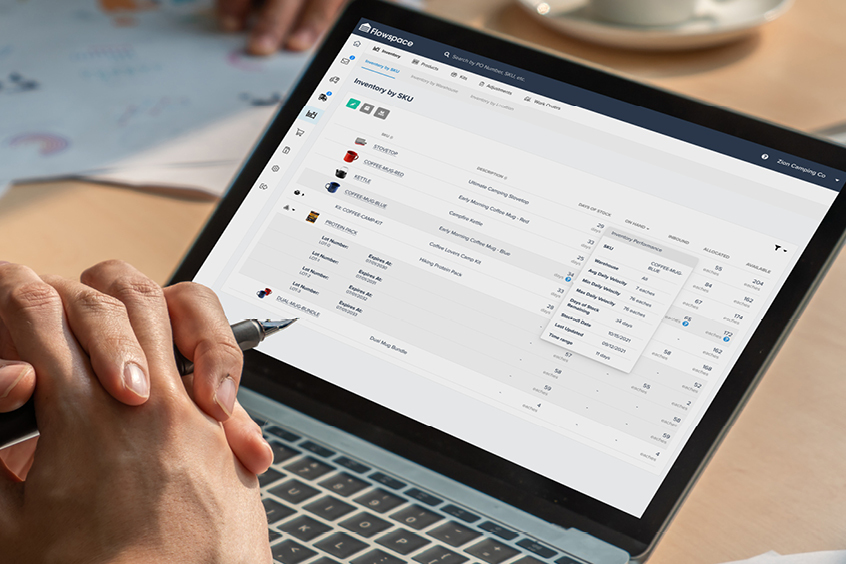
Stock level accuracy is essential for a profitable ecommerce business, but what is inventory control, and how does it relate? It’s important for retail brands to maintain stock control over their inventory level and their fulfillment process, and ensure order accuracy to maintain positive profit margins and solid customer relationships.
What Is Inventory Control & How Is It Different From Inventory Management?
Though the terms sound similar, inventory tracking and control is the actual process of inventory regulation in the warehouse. Inventory management systems involves the strategy of forecasting and restocking inventory count based on data assessments of when to order stock, how much to order, and which supplier to order it from.
So, what is the purpose of inventory control? An effective inventory management control system is designed to streamline good inventory control management through automation to accurately track orders and shipments.
Tracks quantities of goods and materials
Inventory control systems track which items are being used to fulfill customers’ orders and at which time. It follows a system that translates exactly when and how pallets or units of inventory are received, stored, transferred, and tracked in real-time through a FIFO, FEFO, or LIFO method. By doing so, it helps brands determine how to best allocate physical inventory, excess stock, and finished goods.
Addresses quality assurance of items
Part of inventory control also confirms the quality of stock in the warehouse to confirm there’s no spoilage or damage to the physical inventory. Knowing the exact status of each inventory item ensures customers receive shipments intact and as expected every time, creating an optimal experience that increases trust and confidence in the brand.
Evaluates inventory real-time
Both proper inventory management and inventory control systems can track items in real-time. However, inventory control focuses on real-time operations of every purchase order placed and fulfilled. Proper inventory management uses inventory control data to forecast demand for future inventory restocks and sales projections.
Why Is Inventory Control Important For Retail Brands?
Inventory control is a retail fundamental, and modern brands are tapping into innovative new processes, finding ways to automate and optimize the inventory system using data and insights.
Quality control
An inventory control system automates the process of tracking products from purchase order to delivery status, eliminating the risk of human error as often experienced with physical tracking. The technology also allows multiple storefronts to be integrated into one supply chain management system to accurately track inventory in real-time from a brand’s various marketplaces and shopping carts.
Organizational control
A strategic approach to overcome supply chain disruptions is through inventory forecasting and control of inventory records to improve efficiencies within a supply chain model. There are multiple steps that occur from the time a customer places an order to the point the finished product reaches their door. This means everything must be on time and in sync in order to meet customer satisfaction expectations.
An inventory control method allows brands to identify areas for improvement within the workflow and eliminates some of the manual warehouse management tasks that can take up valuable time and resources that can help a company grow. Inventory forecasting also identifies the amount of safety stock held, which is crucial for any business due to the importance of safety stock in inventory management.
Accounting accuracy
Data obtained through inventory control also ensures inventory accuracy, which helps keep inventory at optimal levels to benefit profit margins. Out-of-stock products and backorders can derail a strong customer relationship, and overstock can lead to an increase in storage and insurance costs. When there are discrepancies, it can quickly affect the customer experience and, ultimately, the brand’s bottom line. Inventory control data and software can also help determine inventory turnover, easing the burden on any brand manager responsible for knowing how to calculate inventory turnover.
DTC and B2B Brands That Have Mastered Inventory Control
Brands that have expanded their reach to compete in both DTC and B2B – online and in stores – are able to most effectively scale with an inventory control software system in place. Two examples of brands that have mastered good inventory management are Reel Paper and Rukket Sports.
When Reel Paper experienced a significant spike in orders, the brand turned to Flowspace to power its retail fulfillment solution. Reel Paper was able to deploy an inventory control system and maintain real-time visibility and control over inventory and orders, enabling them to manage the influx of customer demand with each customer order.
Reel was able to maintain accurate, on-time deliveries through Flowspace’s network optimization and omnichannel fulfillment capabilities. Maximizing the opportunity to scale, Reel Paper successfully continued selling direct to consumers while also expanding into retail fulfillment in Target stores nationwide.
Similarly, Rukket Sports implemented Flowspace software to navigate both a DTC operation and through fulfillment into retail with Dick’s Sporting Goods. The Flowspace platform allows brands like Rukket and Reel to handle omnichannel fulfillment by centralizing DTC and retail logistics in one place, simplifying inventory control and order management for both.
What Are The Common Challenges With Inventory Control?
The basic process of inventory control can lend itself to challenges that can be addressed through automated order fulfillment and machine learning.
Visibility
Visibility over the entire perpetual inventory system can be challenging, particularly when there are multiple sales channels in play. This lack of visibility also reduces tracking levels to provide updates for customers regarding their orders.
Time and resources
Some brands manually log inventory, which may be the simplest way to track products but not the most efficient. Even for small businesses, this ongoing task takes up precious time and operational resources, which could be used in other areas to effectively grow the business.
Human error
When handled manually, there’s a higher risk of human error, which can be costly to a company. Inaccurate data, inconsistent updates, and/or misplaced items, whether on the warehouse shelf or in the spreadsheet, can be costly for companies.
How Can These Challenges Be Addressed?
Flowspace technology streamlines the inventory control process and provides insights regarding inventory management which empowers brands to make profitable data-driven decisions.
Use real-time inventory tracking capabilities
Real-time visibility offers brands complete control and insight to track inventory from every channel, at every fulfillment center, from the time an order is placed until it’s delivered to a customer’s door. This real-time visibility is also useful to customer support teams who can proactively inform customers with order updates or alerts, getting ahead of any “where is my order?” inquiries.
ABC analysis
Ranking the value of inventory through an ABC analysis gives brands insight into which items require restocking more frequently due to high demand versus those which don’t need to be replenished as often. This saves on time, resources, and inventory costs by preventing overstocks and creates a consistently steady inventory flow.
Set reorder points
Furthermore, establishing set reorder points allows the inventory control system to automatically trigger reorders of certain products to keep supply and demand in balance. Flowspace software helps brands make decisions based on their own historical order data and customer insights.
Centralizing Your Inventory Control System
Flowspace conveniently handles omnichannel retail fulfillment for brands, allowing them to meet expectations for both the B2B and DTC model. By providing data points and insights regarding inventory from across all storefronts in real-time, brands can determine key areas of profitability and identify others that may need improvement. With the power of technology, many manual tasks can be automated, saving on time and costs and minimizing risks. It’s a way to ensure enough inventory is in supply at all times to always meet customer demand and reduce missing any potential sales opportunities.
Find out how Flowspace can help your brand with inventory management and control to maximize business success. Get in touch with a fulfillment consultant today.
Sources:
- Netsuite. Inventory Control vs. Inventory Management: What’s the Difference? https://www.netsuite.com/portal/resource/articles/inventory-management/inventory-management-inventory-control.shtml
- Big Commerce. What Is an Inventory Control System? https://www.bigcommerce.com/ecommerce-answers/what-is-an-inventory-control-system/






